Conveyor Belt System Pig Feed Farming Simulator 17
Conveyor Belts are a new category of tools in Farming Simulator 17, whose purpose is to shift Piles of material from point A to point B along a series of moving belts. A Conveyor Belt system is a good alternative to using a Loader, particularly for loading cargo into a Container. Conveyor Belts are tricky to set up, and are not very mobile, but once set up they are extremely easy to use.
A Conveyor Belt system is set up by connecting together up to three different types of "pieces":
- A Pickup Belt piece can lift materials from Piles on the ground onto the conveyor system.
- A Horizontal Belt piece can move that material a long distance from the starting point, or even around corners.
- A Vertical Belt piece can raise the materials far above the ground, e.g. before dumping it into a Container.
None of the three pieces are mandatory - a conveyor system can work with any combination of any of the three groups, and you can connect multiple pieces from a single group together, if you need to. It all depends on what you're trying to accomplish with the particular Conveyor Belt system that you are setting up.
Materials can be dumped onto Conveyor Belts in a variety of ways. They will always travel in a given direction, and will automatically continue from piece to piece, if the pieces are set up correctly. Any Conveyor Belt piece will dump its cargo into a receptacle if one is detected at the end of the belt, and can also be instructed to dump its cargo on the ground to create a new Pile.
Each Conveyor Belt piece can also be driven (at a very slow speed and low maneuverability) to adjust its position. Most pieces can be adjusted in various ways in order to connect them to one another and to precisely dump the cargo wherever it's needed.
Farming Simulator 17 offers 3 different Conveyor Belt models - one from each of the three categories listed above. Since each piece performs a completely different function along the belt system, they are not in competition with one another at all. Nonetheless, Conveyor Belts in general are in competition with Loaders for the task of moving loose cargo around.
List of Conveyor Belts
Below is a list of all Conveyor Belts available in the base game. Each belongs to a different subcategory of belts. They can all be found in the "Conveyor Belts" category at the store.
| Name | Price | Maint. Cost per Day | Belt Type | Front Hitch | Conveyor Hitch |
|---|---|---|---|---|---|
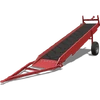 | 5,000 | 5 | Pickup | Drawbar (Ball) | Rear |
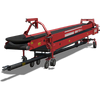 | 8,000 | 10 | Horizontal | Three-point hitch | Front & Rear |
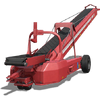 | 12,000 | 10 | Vertical | Three-point hitch | Front |
Subcategories
Conveyor Belts come in three distinct varieties: Pickup Belts, Horizontal Belts, and Vertical Belts. Each type of belt performs a completely different function as part of a combined Conveyor Belt system. The system may contain any combination of these three piece types, depending on what purpose the conveyor system has been set up for, as explained in the next chapter.
Pickup Belts
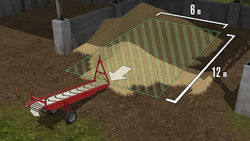
This schematic shows the pickup zone and operation of a Lizard S-710 Pickup Belt.
The purpose of a Pickup Belt is to pick materials up from a Pile on the ground, and move them up onto the next belt in the system. The Pickup Belt itself is a short ramp: One end of the belt touches the ground, and then it climbs up a short distance in the air before coming to an abrupt stop. Materials travel up this ramp and fall over into the next conveyor belt piece in the system.
The Pickup Belt automatically scans for any Piles within a large area in front of the input end (the end that's touching the ground). When it finds a pile within that area, the Pickup Belt will constantly suck in materials from that pile, move them up the ramp, and dump them over the edge. The Pickup Belt continues to lift more and more materials as long as it has anything to dump them onto (e.g. another belt).
The output end of the Pickup Belt is not very high off the ground - just high enough to dump materials onto another belt piece. It is not tall enough to go over the side of a Tipper, but it might be able to dump materials into a very small Sowing Machine or similar tool.
A Pickup Belt can be ordered to "Unload Here" ![]() Conveyor Belt: Unload Here Default Buttons:
Conveyor Belt: Unload Here Default Buttons:  L.Ctrl + I
L.Ctrl + I  ??
??  ?? - but there is not much point in doing so.
?? - but there is not much point in doing so.
Horizontal Belts
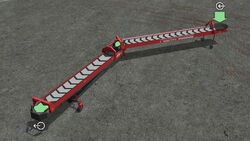
This schematic shows the operation of a Grimme TC 80-16 Horizontal Belt, with its parts fully extended and slightly angled.
A Horizontal Belt, as its name implies, is designed to move materials across a considerable distance horizontally. This piece consists of two long conveyor belts, which can be stretched out to well over a dozen meters. It is used to automatically move materials between two distant points.
The Horizontal Belt is typically installed in the middle of a Conveyor Belt system, between the start and end points. The more distance you need to cover, the more Horizontal Belts can be added to the system, potentially covering a massive distance when many of them are chained together.
The input end of a Horizontal Belt only accepts cargo "from the air" (see below), usually from a Pickup Belt (see above). The material travels along the entire belt, and will automatically fall off the output end if there is anything there to receive it (e.g. a Vertical Belt, a Container, and so on).
The two halves of the Horizontal Belt can be freely angled relative to one another. This allows the belt to go around a corner or an obstacle. Materials will automatically flow from one half to the other at the hinge point.
The input end and output end of the Horizontal Belt can be raised or lowered as well, but not to any great height. The purpose of this is to allow the input end to fit underneath the previous Conveyor Belt piece in the chain, or to raise the output end above the next Conveyor Belt piece in the chain. The output end cannot be raised far enough to unload materials into a Tipper.
Vertical Belts
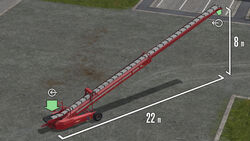
This schematic shows the operation of a Grimme SL 80-22 Quantum Vertical Belt, fully extended and raised.
A Vertical Belt is a long ramp, leading from ground-level to a significant height above the ground. Material goes up the ramp, reaches the end of the belt, and spills over - preferably into a Container.
The Vertical Belt is typically the last piece in a Conveyor Belt system; all other belt pieces simply lead the material to it. Without a Vertical Belt, a belt system cannot fill most machines and containers at all.
The output end of the Vertical Belt can be raised very high above the ground - easily high enough to fill any Container or any other machine in the base game. The Vertical Belt can also stretch out to a pretty good horizontal distance if needed, but unlike a Horizontal Belt it cannot bend or angle itself around obstacles.
Vertical Belts can also be used to create new Piles at a given location. Because the end of the belt is so far up in the air, there is plenty of room underneath it for a large new pile to form. Additionally, you can use a Hired Worker to automatically swing the output end of the Vertical Belt from side to side, creating a large crescent-shaped pile. This is a great tool for arranging loose cargo for storage in large quantities.
Setting Up
Setting up a Conveyor Belt system is a process of several stages which can take some thought, time, and effort:
- Determine exactly what you want the system to do once it's constructed, how you want to load materials onto the belt, and where you'd like to drop them off.
- Purchase the correct pieces for the job. It's very easy to waste money on pieces you don't actually need.
- Tow the pieces to the assembly area, and carefully line them up to the input material pile (if any) and the output location.
- Optionally, hook the pieces to one another to help keep the entire belt together.
What Pieces to Buy?
Before building a new Conveyor Belt, you need to decide which pieces you're going to need, depending on what you need done. It's easy to buy the wrong pieces by mistake, and there may be nothing else to do with unwanted pieces except sell them - so give this some consideration.
If you're going to load from a Pile on the ground, you're definitely going to need a Pickup Belt. None of the other pieces can collect materials directly from the ground. Building a Conveyor Belt system without a Pickup Belt piece is possible, but you'll need to dump materials directly onto the belts ("Air Filling"), which usually means using a Loader or a machine that can directly dump its contents.
Now consider the distance between your loading point and the intended unloading point - where the materials will be dumped (on the ground or into a container). Are they far apart? Are there obstacles between them? If either answer is yes, you may need at least one Horizontal Belt. Remember that the Grimme TC 80-16 is very long when fully extended (up to around 20 meters), but for some jobs you may need more than one of them. Also note that this belt cannot be shortened to less than about 10 meters. If you don't need too much distance, always remember that the Grimme SL 80-22 Quantum Vertical Belt can also be extended to a very long distance - but it cannot be angled at all.
Finally, if you want your Conveyor Belt to fill anything larger than a small Sowing Machine or similar device, you're definitely going to need a Vertical Belt to lift the materials high off the ground. Neither Pickup nor Horizontal belts can lift materials beyond about 1.5 meters off the ground - a Vertical Belt is absolutely required for anything taller. Again, remember that a Grimme SL 80-22 Quantum Vertical Belt can be extended quite a distance away, too.
Towing
Note that of the tools available in the base game, only the Lizard S-710 has a Drawbar (Bolt). The other two belt pieces have a Three-point hitch that can only hook to a Tractor - despite their 3D models that looks like they would use a drawbar.
Once the pieces are at the assembly area, you can unhook them from the towing vehicle, and then Enter ![]() Enter Vehicle Default Buttons:
Enter Vehicle Default Buttons:  E
E  ??
??  ?? and drive each piece into position. Conveyor Belts move very slowly, but you have full control of movement and orientation, which is far easier than trying to back them into position with a towing vehicle.
?? and drive each piece into position. Conveyor Belts move very slowly, but you have full control of movement and orientation, which is far easier than trying to back them into position with a towing vehicle.
Remember to place the Horizontal Belt (if any) in the correct direction. The input end has a small basin where materials should come in. At the output end, the belt comes to an abrupt stop, with a flat solid cover to prevent materials from flying off. The two ends look different enough to distinguish between, and learning to recognize them can prevent frustration later on.
Hooking Up
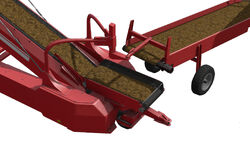
A close-up of two Conveyor Belt pieces hooked to one another.
Once the pieces are in place, it's generally a good idea to connect them to one another to form them into a single machine. Each belt piece has at least one connection point (the Horizontal Belt has two; one at either end) where another piece can connect to. Getting the connection right can be tricky, but it's doable.
With the pieces connected to one another, you can be sure that materials will always flow from one piece to the next. You should still be able to reorient the pieces when they are connected (by Entering a belt piece ![]() Enter Vehicle Default Buttons:
Enter Vehicle Default Buttons:  E
E  ??
??  ?? and adjusting it slightly), if it becomes necessary.
?? and adjusting it slightly), if it becomes necessary.
Loading
Once a Conveyor Belt system is set up, there are two different ways to get materials onto the belt itself. The first is by loading the materials directly from a Pile on the ground, using a Pickup Belt. The second is to pour the materials onto the belt, using a variety of different methods (especially a Loader and Bucket).
Loading from Piles
A Conveyor Belt system can be loaded directly from a Pile of solid material on the ground, without the need for any third-party equipment. To do this, the Conveyor Belt must begin with a Pickup Belt piece, which automatically collects materials from a Pile and places them on the next belt piece.
The Pickup Belt needs to point its input end (the end touching the ground) towards the Pile you wish to pick up. The pickup zone is quite large, and should be able to pick up even very large piles. The materials will automatically be moved up the belt and spilled onto the next piece in the chain.
This is the most commonly used method, since Conveyor Belts are typically set up specifically for the purpose of making the loading process easier. A Pickup Belt can collect a vast amount of material with barely any effort from the player this way, whereas the alternative would be to shovel the material from the pile (either onto the conveyor belt system, or into whatever the system was designed to fill).
Loading from the Air
The alternative is to pour materials directly onto the belt. Materials can be poured onto a Horizontal or Vertical belt, without the need for a Pickup Belt.
Materials can be spilled onto a belt from a variety of machines. For example, a Harvester can unload its cargo automatically onto a Conveyor Belt, simply by placing the end of the Harvester's output pipe over the input point of the Conveyor Belt, wherever it might be. Materials will automatically spill onto the belt, and be carried off to wherever they are needed. A Loader with a Bucket can do the same thing, shoveling materials onto the belt.
Pallets can also be used for this purpose, and may actually be easier to use. Simply placing a Pallet next to the input end of the belt will cause materials to be sucked into the belt system. Alternatively, you can hold the Pallet over the belt's input end (using a Pallet Fork or similar device) to cause materials to automatically spill out.
Loading from the Air is typically not an efficient way to do things. If a Pickup Belt piece is present, all you need to do is spill the materials in front of the Pickup Belt and they will automatically be loaded into the belt system - as explained above. However if a Pickup Belt is not present, it's good to know that Loading from the Air is an option.
Unloading
The ultimate purpose of a Conveyor Belt is to dump the loaded materials somewhere else. Most commonly, this will be a Container or machine that is driven under the output end of the belt, but Conveyor Belts can also unload into designated unloading spots (like Feeding Troughs), into farm equipment (like Sowing Machines), or even onto another set of belts.
Each belt piece has an Output point equipped with a built-in "sensor". Whenever a suitable receptacle is located directly underneath the output end, the sensor activates the belt, causing it to dump its materials automatically, assuming it is currently carrying any materials. When initially setting up a Conveyor Belt system, this can actually happen as soon as you put the first two belt pieces together, since a Conveyor Belt piece is itself a valid triggering receptacle for the previous piece.
This mechanism is what pushes materials along the belt from piece to piece:
- Materials are poured into the first piece (or picked up by it automatically, if it is a Pickup Belt).
- The first belt piece is immediately triggered by the presence of the next belt piece in the system, pouring the materials into that next piece.
- This goes on from piece to piece, until the material finally arrives at the last piece.
- If the last piece locates something to dump the materials into, it will do so. Otherwise, it begins accumulating materials until full, at which point it stops being a "Valid" receptacle to the piece behind it, causing the entire system to pause loading materials altogether, until that last piece can be cleared.
The process outlined above is completely automatic - so long as the belt has anything to dump its cargo into. There are no need to press any buttons, but you do need to ensure that the belt has materials to load.
Alternatively, if the situation requires, a Conveyor Belt can even be instructed dump the materials on the ground, creating a new Pile. This is done by entering the last piece in the chain ![]() Enter Vehicle Default Buttons:
Enter Vehicle Default Buttons:  E
E  ??
??  square , and hitting the "Unload Here" button
square , and hitting the "Unload Here" button ![]() Conveyor Belt: Unload Here Default Buttons:
Conveyor Belt: Unload Here Default Buttons:  L.Ctrl + I
L.Ctrl + I  ??
??  ?? . The Conveyor Belt system will then continue to dump any cargo that is loaded onto it, until it runs out of cargo, or until the resulting Pile runs out of space on the ground.
?? . The Conveyor Belt system will then continue to dump any cargo that is loaded onto it, until it runs out of cargo, or until the resulting Pile runs out of space on the ground.
Unloading into Containers
One of the most common uses for a Conveyor Belt is to automatically fill Containers with cargo, especially from a large Pile. As soon as a valid Container is placed underneath the output end of the belt, the belt will continuously load more and more cargo, dumping it into the container. This will only stop if the container is full, if the container drives away, or if the belt runs out of cargo to load.
This method is commonly used to load Silage into containers directly out of a Silage Bunker, or Manure out of an Animal Pen. It can also be used for any other material, as long as the container in question can carry that material (Tippers can carry anything a Conveyor Belt can load).
Note that only a valid container will trigger a Conveyor Belt system. This means the container must be capable of carrying the materials being loaded by the belt. Furthermore, if the container is carrying more than 4% of any material, it cannot be filled with any other material. Read the article on Containers for more information.
Unloading into Machines
Another important use of Conveyor Belts is to load an Implement with the materials it needs in order to work - e.g. filling a Sowing Machine with Seeds or Solid Fertilizer.
To be a "valid" receptacle, the machine must be able to use the cargo being loaded into it, have room for that cargo, and have its cover open ![]() Open Cover Default Buttons:
Open Cover Default Buttons:  N
N  ??
??  ?? . Otherwise, the belt will refuse to spill materials into that machine.
?? . Otherwise, the belt will refuse to spill materials into that machine.
This method for filling machines is only really suitable for loading cargo that has previously been dumped in a Pile on the ground. Most machines use cargo that is purchased in Pallets, and can refill directly from those pallets. Therefore, turning the Pallets into a Pile and then building a belt to load the material back into machines is a waste of money, time, and effort. Furthermore, if you need a way to store massive quantities of these materials and fill your machines easily, consider buying an Auger Wagon instead, as it is incredibly efficient as a Seed and Solid Fertilizer dispensary.
Nonetheless, one good use for this method is to load Potatoes into a Potato Sowing Machine. Potatoes are acquired in loose form (when harvested), and can then be dumped in a pile next to a Conveyor Belt and loaded into those sowing machines very easily. This is significantly easier than any other method of loading potatoes.
Dumping into Designated Spots
Conveyor Belts can also be used to unload materials directly into static unloading spots on the map, such as the Silage sale point at the Biogas Plant, the Feeding Troughs at the Animal Pens, and potentially other similar unloading spots.
The process is pretty much identical with this method as with loading containers or machines (see prev. subsections), except the unloading point is immobile. Simply build a belt system to start at a position where you can easily unload your Piles, with the output end hovering right over the designated unloading spot. The belt will continuously dump materials into that spot as long as there is a Pile to load from, and as long as there is room in the unloading spot.
This method has limited usefulness, since most designated unloading spots will happily accept cargo dumped directly from a Container or similar machine. However, one advantage of a Conveyor Belt in this setup is that it triggers automatically. This is very important when the unloading spot has limited space: As soon as more space becomes available at the unloading spot, the belt will automatically fill it up with more material from the pile. For example, you can place a Conveyor Belt to feed your animals, with a large pile of materials for it to load from; It will pour more and more material into the feeding trough each time the animals eat some - without any additional effort or attention required from you.
Dumping on the Ground
Finally, a Conveyor Belt can be instructed to unload its materials directly on the ground, using the "Unload Here" command. To activate this option, climb into the last piece in the system ![]() Enter Vehicle Default Buttons:
Enter Vehicle Default Buttons:  E
E  ??
??  ?? and hit the "Unload Here" button
?? and hit the "Unload Here" button ![]() Conveyor Belt: Unload Here Default Buttons:
Conveyor Belt: Unload Here Default Buttons:  L.Ctrl + I
L.Ctrl + I  ??
??  ?? . The system will continuously unload any materials placed on it (or pulled into it with a Pickup Belt) in a new Pile created underneath the system's output end.
?? . The system will continuously unload any materials placed on it (or pulled into it with a Pickup Belt) in a new Pile created underneath the system's output end.
This method can be used to move materials from one place to another across a long distance without transporting it manually. For example, instead of driving your Tipper all the way to the other end of a field to dump cargo, you can build a belt that will automatically take it there from this end of the field.
elsberryprepertion63.blogspot.com
Source: https://farmingsimulator.fandom.com/wiki/Conveyor_Belts/Farming_Simulator_17
0 Response to "Conveyor Belt System Pig Feed Farming Simulator 17"
Postar um comentário